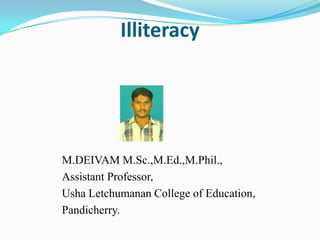
Illiteracy
- 1. Illiteracy M.DEIVAM M.Sc.,M.Ed.,M.Phil., Assistant Professor, Usha Letchumanan College of Education, Pandicherry.
- 2. Illiteracy: A person who is unable to sign and unable to read and write, in simple sentences is called illiterate.
- 3. Introduction to Illiteracy Illiteracy is one of the biggest problems that India is facing in contemporary world. Illiteracy is the mother of various other issues like poverty, population explosion, unemployment, child labor. Illiteracy is a major stumbling block in the growth and development of the country. The majority of the population in India is still illiterate which is hampering the progress.
- 4. Cont.., In India, illiteracy is basically categorized as wide gaps between rural and urban populations. The majority of the people are illiterate especially in rural areas, where people are unaware about the ill effects of being illiterate and moreover facilities are also not ample. The enrolment level of students in primary and secondary grades is very low in rural areas. In spite of various schemes and initiatives by the Government to promote literacy the results are not satisfactory. Even there is a wide variation in the literacy ratio of males and females. India is a male dominated society and thus the right of education seems to be owned by them only.
- 5. Causes of illiteracy 1.Lack of economic means to send the children to the school. 2. Lack of awareness and consciousness 3.No will among the political leadership to educate their people 4.caste divisions and most of the illiterates are from lower castes such as SC/STs and BCs, upper castes were not in their welfare and wellbeing. 5.Budgetary constraints due to over population.
- 6. Cont.., 6.Poverty 7.Poor Government schemes. 8.Lack of schools in rural areas(70 percent of indians live in rural areas) 9.In remote areas, Parents don't send girls to school 10.Child marriages 11.The biggest of them all...corruption...politicians deposit the money which is supposed to be spend on schools in their own account
- 7. Efforts to Eradicate Illiteracy in India A number of significant programmes have been taken up since Independence to eradicate illiteracy among adults. Some of the important programmes included: ¨ Social Education - implemented in the First Five-Year Plan (1951-56). The programme gave importance to literacy, extension, general education, leadership training and social consciousness. ¨ 'Gram Shikshan Mohim' - a movement for literacy in the rural areas started first in Satara district of Maharashtra in 1959 which was later extended to other parts of the state. The programme aimed at imparting basic literacy skills within a period of four months.
- 8. Cont., ¨ Farmer's Functional Literacy Project (FFLP) - started in 1967-68 as an inter-ministerial project for farmers’ training and functional literacy. The project aimed at popularisation of high yielding varieties of seeds through the process of adult education in 144 districts. ¨ Non-formal education (NFE) - launched in the beginning of Fifth Five Year Plan for the age group of 15-25 years.
- 9. Cont., ¨ Functional Literacy for Adult Women (FLAW) - started in 1975-76 in the experimental Integrated Child Development Scheme (ICDS) project areas. The scheme included a component which enabled illiterate adult women to acquire functional skills along with literacy, to gain better awareness of health, hygiene, child care practices and in the process facilitated attitudinal changes. ¨ National Adult Education Programme (NAEP) - launched on October, 2 1978. This was the first programme in India taken up at macro level to eradicate illiteracy through project approach. It was a massive programme aimed at educating 100 million non-literate adults in the age- group of 15-35 years within a time frame of five years.
- 10. Cont., ¨ Rural Functional Literacy Project (RFLP) - the objectives of the scheme were: to impart functional literacy to all illiterate persons in 15-35 age group who are living in the rural areas by organising specified number of literacy centres in accordance with the norms and guidelines issued by the then Department of Education, Ministry of HRD from time to time. ¨ Mass Programme of Functional Literacy (MPFL) - launched on May 1, 1986 by involving National Service Scheme (NSS) and other students in colleges and universities. During 1987-88, NCC Cadets from senior division were also involved in the programme.
- 11. SSA(2002-2003) Free and compulsory education for all age group up to 14. 2007 – V standard completed successfully 2010 - VIII standard completed successfully
- 12. National Policy on Education - 1986 National Policy on Education - 1986 and the Revised Plan of Action - 1992 gave an unqualified priority to the following three programmes for eradication of illiteracy: (a) Universalisation of Elementary Education and universal retention of children upto 14 years of age. (b) Systematic programme of non-formal education in the educationally backward states. (c) National Literacy Mission to impart functional literacy to adults in the age-group of 15 - 35 years.
- 13. Illiteracy costs India more than $ 53 billion a year: New Delhi: Illiteracy is costing Indian economy more than $ 53 billion a year, a report has estimated. According to the report titled 'Economic and Social Cost of Illiteracy' by World Literacy Foundation, illiteracy costs India an estimated $ 53.56 billion.
- 14. NEW DELHI: Nearly 70 per cent of the illiterate population in the country are in eight states of UP, Bihar, Andhra, West Bengal, Maharashtra, Rajasthan, Madhya Pradesh and Karnataka, Rajya Sabha was informed at parliament(2001).
- 16. conclusion Literacy is a strong weapon which can root out the social issues like dowry, corruption and child labor. Literate population can contribute manifolds in the economic and social development of a nation. If India wants to be a developed and powerful nation, then literacy is the key. The government should introduce new schemes and policies and should allocate special funds to promote literacy.
- 17. Thank you
